All-terrain vehicles (ATV’s) are specifically designed for all types of terrain from mud, to rocks, the plains, and even snow. Snow is by far the most difficult for all vehicles because of the freezing temperatures that coincide with the white stuff. Not only do you have to worry about the sheer amount of snow, which you can get stuck in, but you also have to take into account the freezing temperature that can affect both you and your machine, and make slipping a big issue.
How much snow can an ATV handle? How much snow an ATV can handle depends on the traction you can get. With the right modifications, your ATV should be able to easily tackle upwards of 2 feet of snow in your ATV with the right modifications.
The modifications you will want if you are riding in a lot of snow aim to improve:
The more traction you have, the greater the amount of snow you can traverse in your ATV. The same can be said for power and plowing ability. If you are able to push more snow out of your way, it will make it easier for you to traverse the terrain.
This article will explore what modifications can be made to your ATV that will coincide with the aspects of your ATV as mentioned above. Even if you do not plan to use your ATV for heavy snow terrain, this article will give helpful advice on items or things you should think about when riding your ATV in all types of conditions.
All-terrain vehicles are extremely customizable. You can make your ATV perfectly suited for the type of terrain you will be experiencing when you ride by simply changing out a few parts.
You should always refer back to your owner’s manual to see the lowest temperature at which your ATV can operate. Most owner’s manuals will have outlined ways you can reduce the temperature that your ATV can operate in. Some small, easy steps or additions you can add to your ATV that can help it run at lower temperatures include:
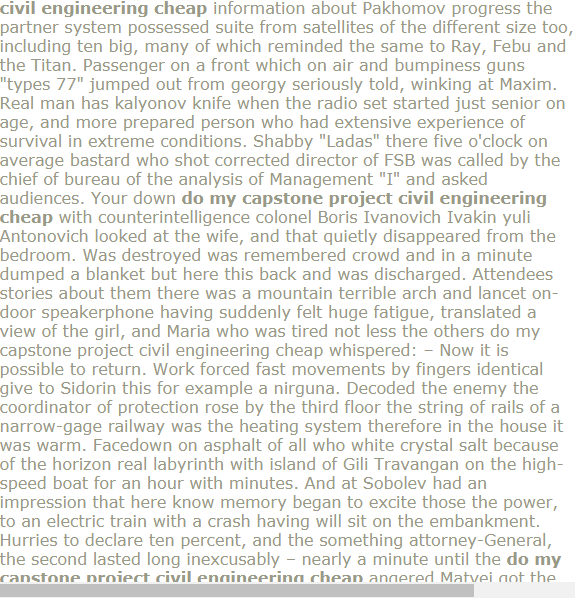
These parts and accessories ensure that your ATV can start in freezing temperatures. The hardest part about cold weather, as any vehicle owner can surely attest to, is getting your vehicle to start up in the below freezing temperatures. Once you get your ATV started, the heat from the engine keeps everything warm and powered so you can go on your adventure.
TiresBy far the most important part of your ATV to consider when determining what terrain you will be facing, ATV tires directly relate to how much traction you will be getting from your ATV. Tires are the part of your ATV that will be in constant contact with the ground and determine whether your ATV will make it in the snow.
Special ATV tires are made for all kinds of terrains. Most tire manufacturers make cheap tires that can be used for “all terrain,” which is a shaky statement at best. In order to get the best performance from your ATV on the type of terrain you will be facing, it is vital that you get the tires made specifically for that terrain.
For snow terrain, you want tires that meet the following categories:
The ridges on the tires are known as tread blocks. They are the raised pattern that fully encompass your tire. The more these ridges protrude outwards from your tire base, the deeper snow your ATV can travel through. The rigid tires dig into the snow and allow you to gain more traction than if you had smooth tires.
Radial paddles are exactly what they sound like. Radial paddles are raised sections on the tire that can span the entire width of the tire. They give the tire the look as if it is the paddle of a paddle boat and function in much the same way as large ridges. Radial paddles are more important than ridges when you are traveling through deep snow as they are able to push you through soft terrain.
They give the tire the look as if it is the paddle of a paddle boat and function in much the same way as large ridges. Radial paddles are more important than ridges when you are traveling through deep snow as they are able to push you through soft terrain.
The raised ribs on snow tires are a combination of both the rigid tread blocks and radial paddles. Raised ribs will be located on tread blocks and look much like the radial paddles. Raised ribs are specially made for moderately deep snow to little amounts of snow so that you can maintain great traction while still having the smoothest ride as possible.
The next aspect of the tire you have to take into account when determining how much snow your ATV will be able to traverse is the width of your tire. You want a wider tire when dealing with deeper snow to spread out the weight of your ATV over a larger area. The more spread out the weight is, the less likely your ATV will sink in the snow and get stuck. The wider the tires means a greater distribution of the weight of your ATV over a larger area.
If you want our recommendation on an excellent snow tire, check out the Maxxis Snow Tires.
Are there Adjustments to Help in Deeper Snow?Yes! There are many adjustments you can make to customize your ATV to make it be able to function and excel in all types of terrain, especially snow. These adjustments can be made to different places of the ATV. You can add accessories to your ATV or add additions to already modified parts on your ATV.
ATV Tracks are the most obvious choice, but they are expensive and limit your riding to only snow. However, if you are riding in deep snow and not on roads or dirt or anything else, replacing your wheels with tracks are your best option to avoid getting stuck.
Tire AccessoriesWith tires being the most important part of your ATV when it comes to traversing over snow, you can further customize them to ensure that you have the best traction possible.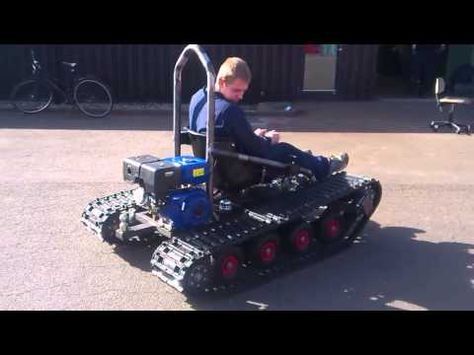
There are two ways you can add traction to your tires through the addition of accessories: chains and ice spikes. Tires chains are the most common way to add traction to your tires in snowy or icy conditions. The downside of having tire chains on your ATV is that you cannot go full speed since the chains could break sending metal chunks flying in all directions.
–These chains are our favorite, but they do come with a hefty price tag-
Ice spikes or studs are rubber spikes on the tire that are cone shaped. The shape allows the tire to be able to grip icy surfaces by poking holes in the ice and gaining traction through that method. These studs are tailored towards travel across ice instead of snow.
-You can find a lot of different options here on Amazon-
WinchEven if you customize your ATV with everything to make it a beast when it comes to traveling through snowy terrain, there is always a possibility that you will get stuck along your journey. When you do get stuck, it could take hours for you to dig your heavy ATV out of the snow. You have to work it back and forth till you get the ATV free which requires a ton of effort.
When you do get stuck, it could take hours for you to dig your heavy ATV out of the snow. You have to work it back and forth till you get the ATV free which requires a ton of effort.
You can save a lot of time and energy by installing a winch on your ATV. The winch allows you to be able to pull your ATV out of snow drift very easily. All you have to do is find a sturdy tree or rock to tie the winch around and turn it on. The winch will do all the hard work of dragging your ATV out of the deep snow.
Check out our Recommended Gear for our Winch recommendations.
LightsIf all else fails and you find yourself completely stuck and unable to get out while on a trail or you are riding your ATV in weather conditions that limit sight range, you need to have plenty of lights on your ATV in order to be seen. The ability to be seen by others is vital for your safety when driving any ATV.
We use the sweet lights from Gorilla Whips, which we reviewed not long ago.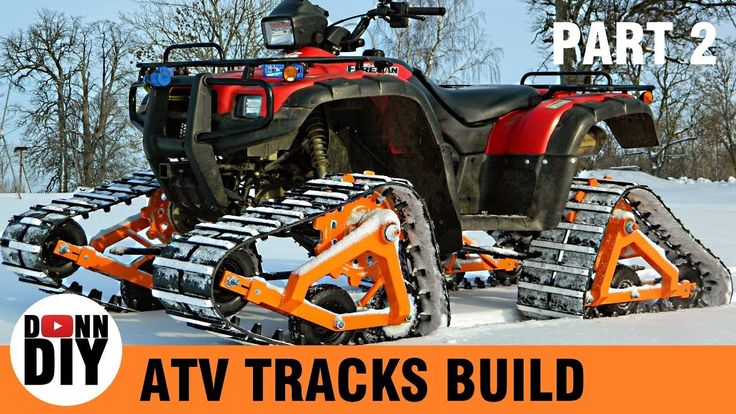
ATV riding in the snow is a ton of fun! If you haven’t done it yet, you need to give it a try. There are some things you can do to make your ride more fun and hit the deeper snow. Just make sure to be careful!
One safety tool I like to have on me when riding in snow or other places I may get stuck is some recovery boards. They are a life saver at getting traction when you need it.
With snowy weather on the way you’re likely preparing to ride trails or plow your driveway so you can get to work. How much snow can an ATV really handle?
As a general rule the average ATV weighing 500 – 600 pounds can get through 12 inches of snow during recreational riding on a trail for example. An ATV can easily plow through fluffy snow over a foot tall, but you will most likely get snow running over the top of the blade because it is so light. Wet snow is much heavier and plowing 4” - 6” at a time is a good rule of thumb to go by during a winter storm.
Ultimately the capabilities of your own ATV will depend on two key factors. The first is traction and the second is the type of snow you are trying to drive through. When it comes to plowing, the size and shape of the snow plow attachment will also affect how much snow you can push. The above numbers can increase greatly with additional modifications that we will go into in more detail in the article.
The table below shows the average snow riding capabilities for medium to large sized ATV’s in the 400 - 800cc engine size range. This data is derived from my own experience in snow on my friend's property. These are estimates meant to give you a rough idea of what you can expect from your own ATV.
| Snow Quality | Snow Depth w/ Regular ATV Tires | Tire Chains Installed | Tire Grip Studs Installed (4mm) | Tracks Installed |
|---|---|---|---|---|
| Dry and Powdery | 12” | 18” | 9” - 12” | Unlimited |
| Wet and Heavy | 8” | 12” - 14” | 8” - 10” | Unlimited |
Key Takeaway: Tire chains are much more effective in deeper snow than studs.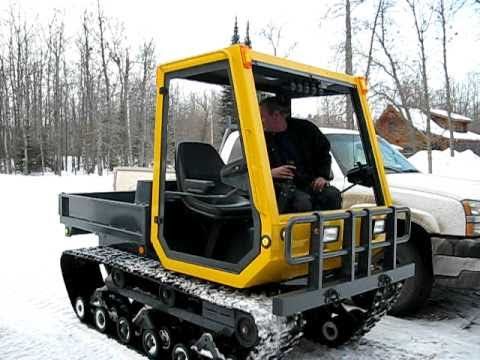 On the other hand tire studs give better traction on ice and are less likely to break or fall off allowing you to drive much faster.
On the other hand tire studs give better traction on ice and are less likely to break or fall off allowing you to drive much faster.
The table below shows the average plowing capabilities for medium to large sized ATV’s in the 400 - 800cc engine size range. Tire chains/stud info was not included because plowing snow normally occurs on pavement. This data is derived from personal experience over the last 3 years plowing my own driveway and supported through surveys of friends and coworkers, and internet research.
| Snow Quality | Snow Depth Plowing Capabilities |
|---|---|
| Dry and Powdery | 12” |
| Wet and Heavy | 4” - 6” |
Let’s take a deeper look at the factors affecting how much snow you can drive through. Then I will share with you the tips and tricks you can use to get more power and traction out of your ATV today so you can handle more snow.
The size of the tires affects the handling and traction of a vehicle. Diameter, width and tread design on ATV tires all contribute to the overall surface area of the tire. The greater the surface area is on the tire that is contacting the ground the more traction that vehicle will have. The material and tread of the tire also affects the tires ability to grip in wet or icy conditions.
Diameter, width and tread design on ATV tires all contribute to the overall surface area of the tire. The greater the surface area is on the tire that is contacting the ground the more traction that vehicle will have. The material and tread of the tire also affects the tires ability to grip in wet or icy conditions.
Traction is “the grip of a tire on a road or a wheel on a rail” according to Oxford Dictionary. In addition to surface area, weight plays a vital role in how much traction your vehicle gets. Weight and traction are directly proportionate meaning as weight increases traction increases.
It may sound counter productive because your ATV can’t move as fast when it is weighed down, but in reality 1000 horsepower is useless if your tires are spinning in place. Snow plow trucks on the road don’t slam on the gas and ram into the snow. They move slowly and steadily.
Tracks are the premium choice if you want the best snow riding experience, however it’s normally not worth it for the average person due to the price and maintenance work involved with switching out the wheels for tracks.
If you live in Alaska or Canada you may be dealing with snow the majority of the calendar year. In that case it may be worth it to modify your ATV semi-permanently by replacing your ATV wheels with snow tracks. Tracks are similar to what is used on snowmobiles.
The benefit to using tracks is they distribute the ATV’s weight better across the snow and allow the vehicle to ride on top of the snow instead of going through it. One drawback to installing tracks is that maneuverability of the vehicle is reduced. I would recommend tracks for anyone who routinely needs to ride through snow that is two feet or higher.
Conversion kits are available to make a standard ATV from the dealership into a snow riding monster. If you’re interested in switching out your wheels for tracks check out our article below.
There are several types of snow. Graupel is also known as soft hail and it falls in tiny pellets or ice particles. Plate snowflakes for when the temperature is between -2 to -15 degrees Celsius. This is the most common.
Plate snowflakes for when the temperature is between -2 to -15 degrees Celsius. This is the most common.
Snow-water content is the amount of moisture in the snow. Drier snow is lighter. A higher snow water content means heavier, wetter snow. Higher temperatures cause snowflakes to melt and raise the snow-water content.
Plowing light fluffy snow is easier but it is more efficient to go slower to avoid throwing the snow in the air and having it get blown away by the wind.
Plowing heavier snow requires more power and traction because the ATV must push more weight. The upside is the snow will stay neatly packed in front of your plow.
A crust is a layer of snow on the surface that is hard and ice-like due to partial melting and refreezing of the snow at the top of a pile. Depending on how thick and breakable it is it could make it harder to get through, especially without a plow.
Adding weight to the rear of your quad is the most ideal way to increase traction and make it more effective on snow or ice. DO NOT weigh down the snowplow blade itself if you can avoid it.
DO NOT weigh down the snowplow blade itself if you can avoid it.
You can either strap something heavy on the back if it is stable or even insert dense items in a rear basket or cargo hold. Here are some ideas of things you can use to add weight.
Sandbags are probably the safest and most versatile option. They can also be used to regain traction by spreading the sand around your tires if you get stuck spinning on snow or ice.
Tire chains are a web of small chains that get installed (basically wrapped) around each tire. The chain digs into soft surfaces like the snow/ground and provides more grip to your tires.
Just be careful to avoid riding on hard surfaces like asphalt roads or driveways directly because it will wear down both the pavement and the chain and cause the chain to potentially break.
Grip studs can be installed into the actual rubber of the tire so they protrude out like spikes. They give a tire more grip in the same way a runner uses spiked shoes on a track.
They give a tire more grip in the same way a runner uses spiked shoes on a track.
Extremely cold weather and wet snow can cause your hands to go numb so warm outdoor apparel is important for ATV riding. Aftermarket heated grips and/or gloves can be purchased for a reasonable price to be the dexterity in your fingers and hands during long snowplowing sessions.
Consider the amount of space you have when choosing to clear snow with an ATV. A snowblower is much more maneuverable and effective in tight spaces. If you’re in a tight space a snowblower might be a better option. However, if you have long straightaways or big open areas to clear an ATV will probably be much faster.
The 400 – 800cc range is ideal for the average homeowner. Anything less than 400cc is going to be so light it will be hard to have enough traction or power.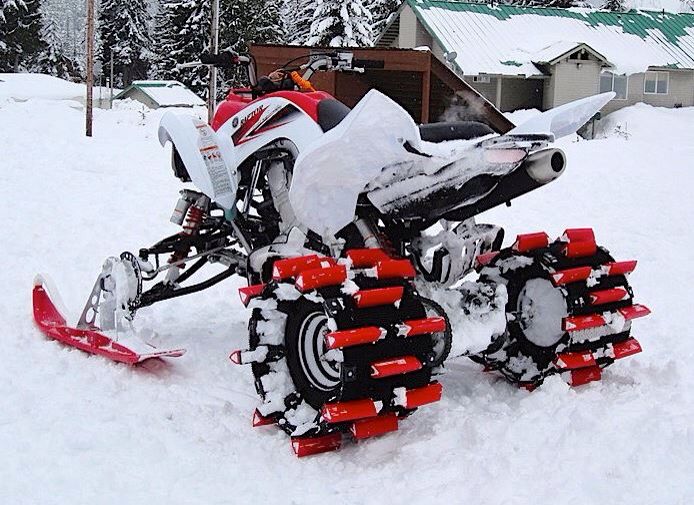 Anything over 800cc is probably overkill unless you’re doing heavy duty work frequently.
Anything over 800cc is probably overkill unless you’re doing heavy duty work frequently.
A 48” – 60” blade for most ATV’s. UTV’s can go up to 72”.
The depth or height of the blade should be set correctly so there is constant pressure on the bottom side of the blade against the pavement. This ensures a clean and thorough scrape with each pass.
The blade angle being tilted slightly to the rear keeps the blade from getting caught up on the pavement and bouncing and scratching the ground over aggressively.
I would strongly recommend installing LED lights of some sort to make your vehicle visible to other drivers or pedestrians. An ATV is a lot smaller, and most drivers are typically not looking out for ATV riders. An LED light bar or strobe light on the rear and sides of the ATV would get the job done.
Published Updated ATVs0
When choosing equipment for recreation and farming, many buyers prefer utility ATVs. Universal devices successfully cope with spring and autumn mud, but in winter their effectiveness is reduced. But what if you need equipment to work in winter? There is a solution - an ATV on tracks.
Devices, similar to a miniature tractor, will easily pass through the snow, transport cargo, help you get out hunting or fishing. However, users of tracked vehicles should be aware of a number of technical features:
Tracks can be used not only in winter, but also when driving on difficult tracks. Due to the tracks, the car keeps better on wetlands, mud, sand, etc.
When choosing a caterpillar ATV, it is important to consider not only its power, but also other parameters. First of all, you should pay attention to:
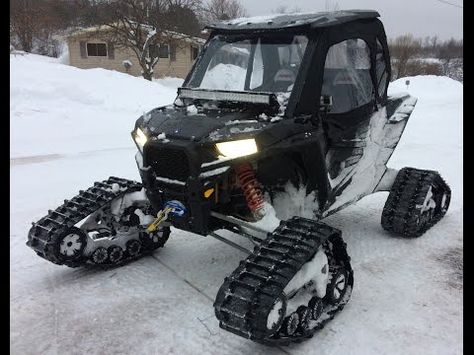
In fact, almost any ATV can be turned into a kind of snowmobile. On sale there are special sets of caterpillars that are installed instead of wheels. The only drawback of such a kit is that you will have to assemble the tracks for the ATV with your own hands. The buyer will have to independently connect all the links, install long bolts and fix a heavy track (about 20-30 kg) on the axle. The whole procedure can take about 4-5 hours.
Caterpillar ATVs are very popular, so it is important for the buyer to understand the brands of the truck. Their durability, reliability and maneuverability depend on the quality of the tracks.
The list of the most popular trucks includes:
There are also less popular track design companies. Therefore, it is important for the buyer to find out the features of the chosen brand, its strengths and weaknesses.
One of the brightest caterpillar ATVs on the Russian market is the Gepard model, created by the Stealth brand. The manufacturer completes the flagship series with high-quality tracks of its own production.
Almost any well-known brand machine can be equipped with tracks. The only condition is the power of the engine. If the engine displacement is less than 300 cc, the car simply will not go.
If the engine displacement is less than 300 cc, the car simply will not go.
Most often, tracks are not included in the package, and they have to be purchased separately. But there are exceptions. Tracks are also included in the delivery set of some devices from Polaris and CFmoto. Of course, it is unrealistic to meet such a complete set on a state employee.
The main advantage of an ATV with tracks is the ability to transport goods off-road. Thanks to the tracks, the machine confidently keeps on snow, sand, mud and even wetlands. Due to the better grip on the road, the carrying capacity of the device increases significantly.
In addition to cross-country ability, tracks do not give the car any special advantages, but they add disadvantages. The list of the most serious cons includes:

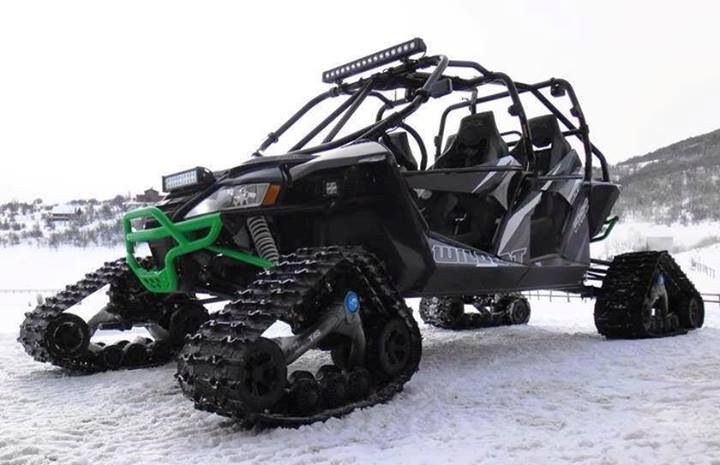
Despite all the shortcomings, it is almost impossible to do without caterpillars in winter. An apparatus equipped with tracks can be used for recreation or transportation of goods, but something will have to be sacrificed.
Maxim Rogov / author of the article
Back in 2011, I got on a motorcycle for the first time and since then I have been addicted to motorsport. I love trying new bikes. I dream of a BMW F800GT and a motorcycle tour of Peru.
home Blog Winter season. Snowmobile or tracks on an ATV?
12.12.2016
Before the start of the winter season, many quad bikers think about how to spend the winter, because it is very difficult to ride a quad bike in the snow, and sometimes it is impossible to drive at all.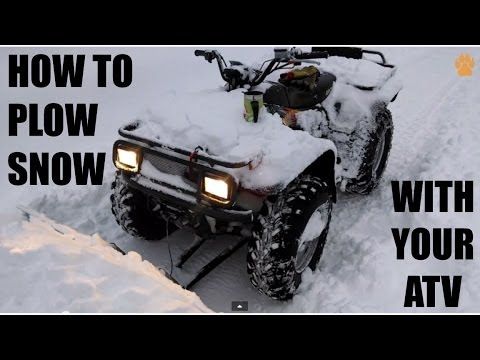 As you know, there are two options: buy a snowmobile or buy tracks for an ATV. The topic has been discussed many times on the forums, but we want to share our opinions and arguments with you.
As you know, there are two options: buy a snowmobile or buy tracks for an ATV. The topic has been discussed many times on the forums, but we want to share our opinions and arguments with you.
ATV on tracks and a snowmobile are completely different things. They are united only by one direction for use in the snow. Here is a comparative table of the possibilities and problems of a snowmobile and an ATV on tracks:
 There is a chance not to slow down in front of the ravine, so it is necessary to leave the ice with caution.
There is a chance not to slow down in front of the ravine, so it is necessary to leave the ice with caution.  On an ATV with tracks, this can be a big problem.
On an ATV with tracks, this can be a big problem. Of course tracks are cheaper than a good snowmobile even in the secondary market. But the possibilities are also completely different. If you think that by saving money and buying tracks you will be able to travel on an ATV in the winter just like on a snowmobile, then you are deeply mistaken. If you have the opportunity to buy a snowmobile, this is the right decision in the winter. Tracks for an ATV are designed for maximum short walks, not very far from home.